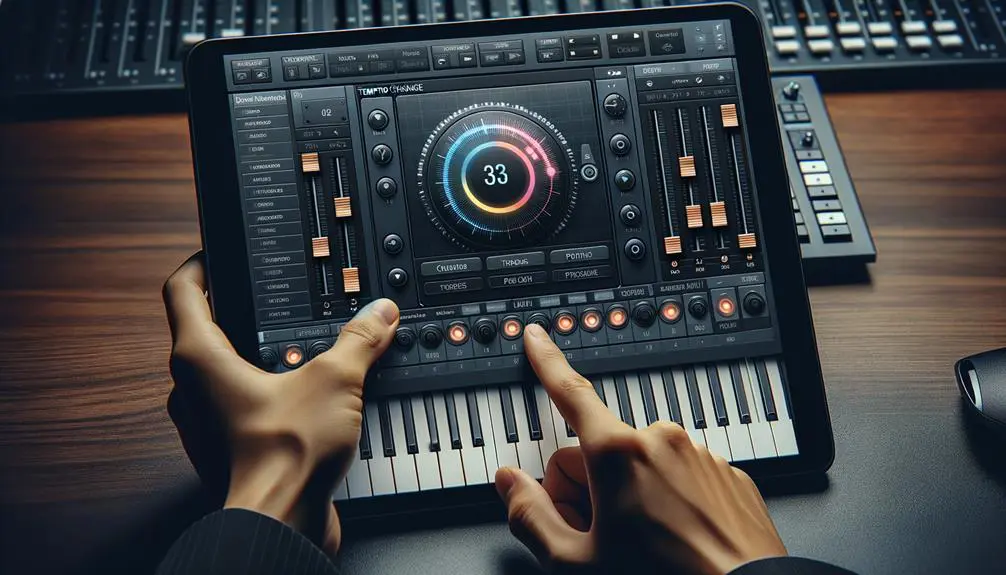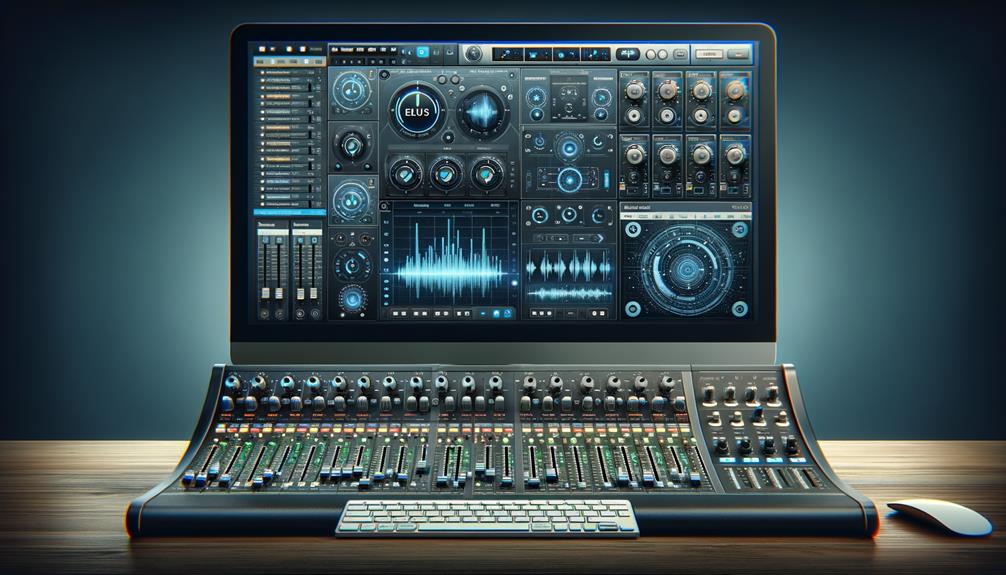To record vocals in Logic Pro X, follow these three easy steps. First, set up your essential equipment, including a high-quality condenser microphone and an audio interface. Connect your microphone to the interface and make certain it’s linked to your computer. Next, configure Logic Pro X by creating an audio track, setting your headphones as the output device, and enabling input monitoring. Finally, arm the audio track for recording, monitor your signal levels to avoid clipping, and maintain a consistent distance from the microphone. By mastering these steps, you’ll achieve high-quality vocal recordings and much more awaits you by exploring further.
Key Takeaways
- Set up your audio interface, condenser microphone, and headphones, ensuring all connections are secure for optimal recording quality.
- Create a new audio track in Logic Pro X and select the correct input source for your microphone in the inspector.
- Arm the audio track for recording and enable input monitoring to hear your vocals in real-time through the headphones.
- Adjust the gain knob to maintain signal levels between -6 dB and -8 dB, avoiding clipping during recording.
- After recording, use EQ and effects as needed, then export your final mix once satisfied with the vocal quality.
Essential Equipment Setup
To successfully record vocals in Logic Pro X, you’ll need three essential pieces of equipment: an audio interface, a high-quality condenser microphone, and a set of headphones.
The audio interface, such as the Apogee One, Scarlett, or Apollo, converts analog signals from your microphone into a digital format that Logic Pro X can process. Opt for a high-quality condenser microphone for superior vocal clarity; while USB microphones are an option, they often compromise audio quality.
Connect your microphone to the audio interface, and guarantee the interface is plugged into your computer for automatic recognition. Additionally, ensuring your audio interface supports low latency performance can greatly enhance your recording experience.
Finally, set the audio output to headphones in Preferences > Audio to eliminate feedback during your vocal recording sessions. This setup will enhance your recording quality considerably.
Configuring Logic Pro X
Once you’ve set up your equipment, configuring Logic Pro X is the next essential step to guarantee a smooth recording process.
The first thing you should do is create a new audio track by accessing “Track” > “New Audio Track.”
Next, access Preferences > Audio to set your output device to headphones and verify the correct input is selected in the inspector window for proper microphone connection.
Make sure the microphone input on your audio interface matches the physical connection and is configured correctly.
Once that’s done, label your audio track clearly (e.g., “Vocals”) for better organization.
Finally, let’s start monitoring your audio signal by enabling input monitoring—click the “I” button in the track header to hear your vocals in real-time. Additionally, consider using autotune plugins to enhance your vocal recordings for a polished finish.
Recording and Monitoring Techniques
Achieving high-quality vocal recordings in Logic Pro X requires careful attention to both recording and monitoring techniques.
First, arm the audio track by pressing “R” or clicking the record button to initiate vocal capture.
Let’s talk about monitoring; enable input monitoring by clicking the “I” button, which allows you to hear your vocals in real-time through headphones.
It’s essential to maintain clarity by monitoring audio signal levels, aiming for -7 dB to prevent clipping.
Adjust the gain knob on your audio interface based on your distance from the microphone and vocal intensity.
I’d recommend keeping levels within -6 dB to -8 dB and watching the visual audio indicators in Logic Pro X to avoid peaking, ensuring a much higher quality recording. Additionally, utilizing vocal EQ during the mixing process can enhance the clarity and presence of your recorded vocals.
Frequently Asked Questions
Is Logic Pro X Good for Recording Vocals?
Logic Pro X excels in vocal recording, offering superior vocal quality through advanced recording techniques. Compared to other software, its integration with audio interfaces and editing capabilities makes it a top choice for professionals and enthusiasts alike.
How Do You Record Your Voice in Logic Pro?
To record your voice in Logic Pro, verify proper microphone selection and connect it to an audio interface. Perform vocal warmups beforehand and apply effective recording techniques to capture clear, high-quality audio.
How Do You Record Vocals Step by Step?
To record vocals step by step, choose the right audio interface, apply microphone placement tips, utilize effective vocal recording techniques, and explore effects processing basics to enhance your sound quality during and after recording.
How to Make Good Vocals in Logic?
To achieve good vocals in Logic, focus on vocal mixing using appropriate microphone techniques, apply pitch correction for accuracy, and experiment with vocal effects to enhance clarity and presence, ensuring a polished and professional sound.
Conclusion
By following these three easy steps, you’ve set yourself up for successful vocal recording in Logic Pro X. Ensuring your equipment is properly configured and understanding the software’s features allows for a seamless recording experience. Remember to utilize effective monitoring techniques to optimize your performance. With practice and attention to detail, you’ll enhance your vocal tracks, achieving professional-quality results that raise your music production. Keep experimenting and refining your approach to achieve the best sound possible.



